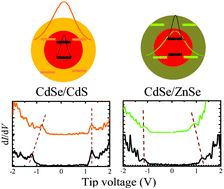Tuning of band-edges in type-I core–shell nanocrystals through band-offset engineering: selective quantum confinement effect
Abstract
The addition of a shell layer onto semiconducting

* Corresponding authors
a
Department of Solid State Physics, Indian Association for the Cultivation of Science, Jadavpur, Kolkata, 700032, India
E-mail:
sspajp@iacs.res.in
The addition of a shell layer onto semiconducting

 Please wait while we load your content...
Something went wrong. Try again?
Please wait while we load your content...
Something went wrong. Try again?
S. Dey and A. J. Pal, RSC Adv., 2013, 3, 13225 DOI: 10.1039/C3RA41525B
To request permission to reproduce material from this article, please go to the Copyright Clearance Center request page.
If you are an author contributing to an RSC publication, you do not need to request permission provided correct acknowledgement is given.
If you are the author of this article, you do not need to request permission to reproduce figures and diagrams provided correct acknowledgement is given. If you want to reproduce the whole article in a third-party publication (excluding your thesis/dissertation for which permission is not required) please go to the Copyright Clearance Center request page.
Read more about how to correctly acknowledge RSC content.
 Fetching data from CrossRef.
Fetching data from CrossRef.
This may take some time to load.
Loading related content
